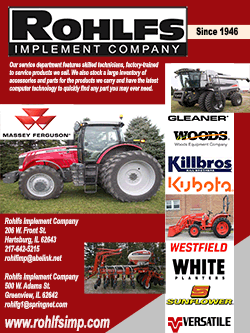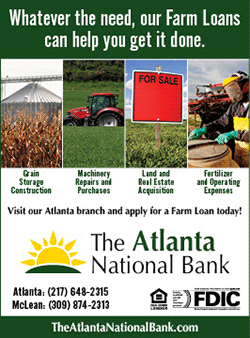|
 What this means for today’s
farmer is that a greater use of technology is coming into play. What this means for today’s
farmer is that a greater use of technology is coming into play.
Specifically, this means that the next few years might see an
increase in more than just human hands and big machines in the
field. Farmers may require more "senses" to be able to see both the
bigger picture and the smaller picture through the working eyes of
robotic assistants and the cameras of drones.
Currently in its infancy, the current use of drones shows us that we
can gain a bird's eye view of what is going on in the field, and
agricultural entrepreneurs are now ramping up their concepts of
drone-use. Colleges such as Illinois Central College in East Peoria
are beginning to offer class in the use of drones and robotics in
agriculture.
According to an article in the Journal Star, “the drone will be as
common as a tractor for farmers one day,” says Blake Lehman, an ICC
instructor. Lehman was one of two instructors who taught the first
classes in the summer of 2018.

“With the use of drones to scout farm fields increasing across the
country in recent years, the feeling was that drone-use warranted
instruction on the use of software along with the creation of flight
plans,” said Lehman in the article.
Pete Fandel, another ICC agriculture professor, wanted to “show
students how to establish a flight plan using specific field
dimensions.” Drones can be programmed to follow a set path, removing
the need for constant control by an operator.
For the moment, drone-use in farm fields seems to be limited to the
use of cameras for data collection. According to Fandel, drone-use
is still restricted by FAA rules and laws. “You’re restricted to the
farm fields and you have to be able to see the drone at all times.
The maximum flying height is 400 feet.”
Lehman says that drones “can be used to track crop population. They
can also fly over an area to see which fields are ready [for
spraying or harvesting].” Alternatively, drones can sometimes track
a farm’s tiling system, alerting farmers when drainage lines are in
plain view or when wet spots linger after a storm.
This limited use may change in the future, especially as competition
with other nations who currently use drones for spray application
grows more intense. For example, companies like ecoRobotix in Sweden
are working on drones that through “a combination of artificial
intelligence and robotics to produce machines that can do the job
[spraying weeds] without human guidance,” according to Nat Williams
of Illinois Farmer Today.
Other researchers in Illinois have similar ideas, and are working
with drones to find ways to detect and spot-treat the spread of
pests and disease in fields. For example, researchers at Southern
Illinois University in Carbondale are working on such technology.
According to an article from SIU, “by using drones to evaluate the
fields, the team at SIU hopes to speed up the process and make farms
more efficient.”

“We go through a plot that is showing disease, and we rate it on a
scale of disease incidence and severity,” says Lindsey Mckinzie, a
graduate researcher at the school. “With the drones what we are
hoping to find out, is if we can use them to rate the plots like we
would with our eye.”
Gathering data involves flying drones over fields and taking
pictures. Researchers compare the data with information gathered on
the ground to determine the effectiveness of the study, and see if
any action can be taken to improve the crops’ health.
Girish Chowdhary, an agricultural engineer at the University of
Illinois, says he believes robots in the field will be common place
soon, although not in a large-scale sense. Williams writes that “a
principle duty of large-farm robotics will be old-fashioned weed
control. That is becoming increasingly important with the growth of
herbicide-resistant weeds, especially those that are becoming
unresponsive to products such as glyphosate.”
In an article for Science Daily, Chowdhary adds that there is “a big
market for these robots not only in the U.S., where agriculture is a
profitable business, but also in developing countries such as Brazil
and India, where subsistence farmers struggle with extreme weather
conditions such as monsoons and harsh sunlight, along with weeds and
pests.”
Chowdhary is also leading a team of crop scientists, computer
scientists and engineers in developing TerraSentia, a crop
phenotyping robot that travels on the ground instead of in the air.
The robot was shown off at the 2018 Energy Innovation Summit
Technology Showcase in National Harbor, Maryland.
The robot analyzes plants using a variety of sensors and cameras,
transmitting the data in real time to a customized app and tablet
computer that come with it, which allows the operator to steer the
robot using virtual reality and GPS. Researchers are currently
working on algorithms to "teach" the robot to detect and identify
common diseases. Additionally, the goal is to teach it how to
identify a variety of traits, including plant size, corn ear height,
leaf area index and biomass.
[to top of second column] |

"These robots will
fundamentally change the way people are collecting and utilizing
data from their fields," says Chowdhary.
Plant biology professor Carl
Bernacchi, one of the scientists collaborating on the project, is
working with data gathered by the robot. “Data collected by the
crop-scouting robot could help plant breeders identify the genetic
lineages likely to produce the best quality and highest yields in
specific locations,” says Bernacchi.
Researchers believe that TerraSentia fills “a big gap in the current
agricultural equipment market between massive machinery that
cultivates or sprays many acres quickly and human workers who can
perform tasks requiring precision but move much more slowly.”
"A robot or swarm of robots could go into a field and do the same
types of things that people are doing manually right now, but in a
much more objective, faster and less expensive way," Bernacchi said.
Seed companies, large U.S. universities and overseas partners field
tested 20 of the TerraSentia robots last spring through an early
adopter program. Chowdhary said the robot is expected to become
available to farmers in three years or so, with some models costing
“less than $5,000.”
Despite a fear among some objectors, Chowdhary doesn’t believe large
robots will replace human-operated machines for tasks like planting
and harvest. “There are challenges in making robotic large equipment
for farms…they’re big and can cause a lot of damage. It’s difficult
to imagine that robotics will be a solution to harvesting large
fields.”
Additionally, while GPS technology is useful, robots cannot overcome
every obstacle. “GPS can get the robot to know where it is on the
farm, but you’re still dealing with a blind robot,” says Chowdhary.
So what comes out of this increase in technology? The answer is
valuable data.

According to a report from Illinois Farmer Today, “data is the new
oil — a currency, what people trade on," said Jayma Appleby,
Illinois Soybean Association’s director of industry relations. Data
is part of modern decision-making, developing risk management
strategies, and identifying more efficient processes; both at the
individual and company level.
For the moment, concerns over security and authenticity of data are
of great importance for farmers. Coulter writes that there is a
larger need for farmers to trust computer data gathered by machines.
“People and processes, not technology, are the prime barriers to
fuller integration of data.”
Any machine on the farm would still need to know the difference
between crops and weeds. Also, they would need to be able to make
decisions about obstacles; things like puddles would be a problem.
“GPS doesn’t give you the answers to any of these. Not only that,
but GPS doesn’t really work that well under the canopy,” Chowdhary
said. “As plants grow, they block the GPS signal because plants are
70 percent water, and water is not a friend of the GPS microwave
signals.”
As we move forward, both farmers and scientists are working on these
concerns. In the next few years, we will hopefully be able to
witness the drone and robotic results of many years of hard work and
technological innovation.
Sources
Coulter, Phyllis.
“Data: New currency in agriculture.” Illinois Farmer Today. 10
Aug. 2018.
Erickson, Hannah. “The
future of agriculture: using drones to fight crop diseases.” SIU
News. Southern Illinois University. 1 Aug. 2018.
Tarter, Steve. “Drone
operation has launched as an ICC agriculture class.” Peoria
Journal Star. 19 Aug. 2018.
University of Illinois at Urbana-Champaign. "Ag
robot speeds data collection, analyses of crops as they grow."
ScienceDaily. ScienceDaily, 12 March 2018.
Williams, Nat. “Robot
technology gaining ground in row-crop farming.” Illinois Farmer
Today. 23, June 2018.
|